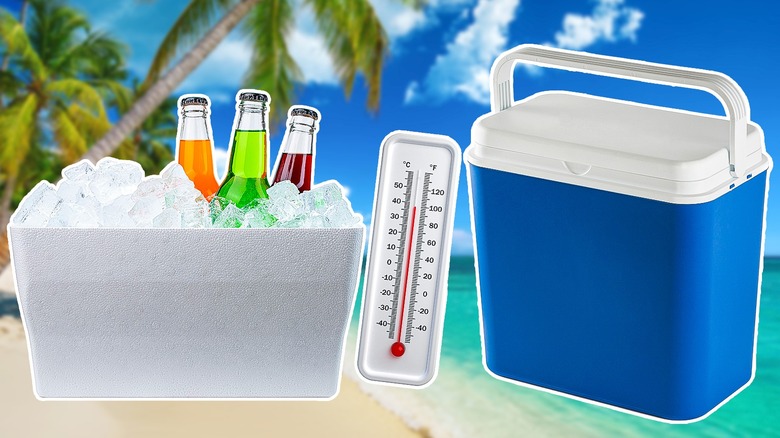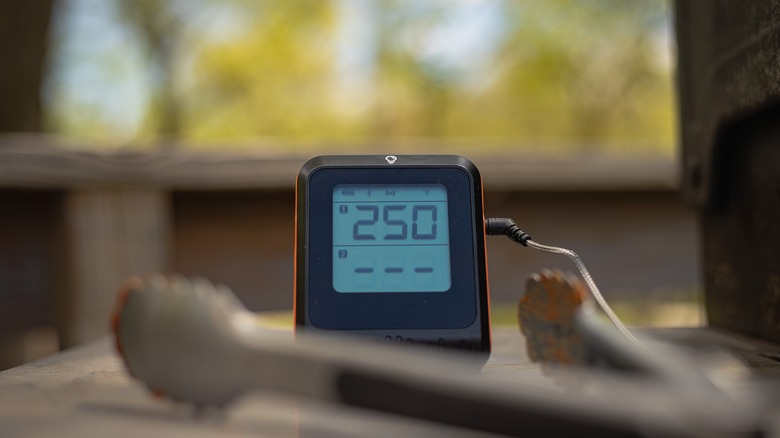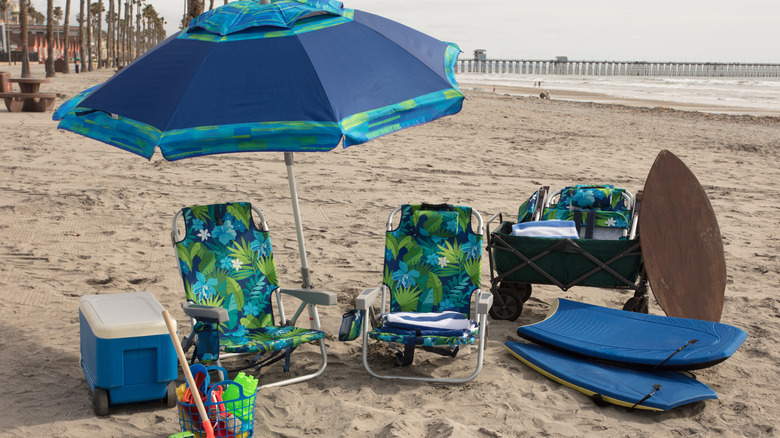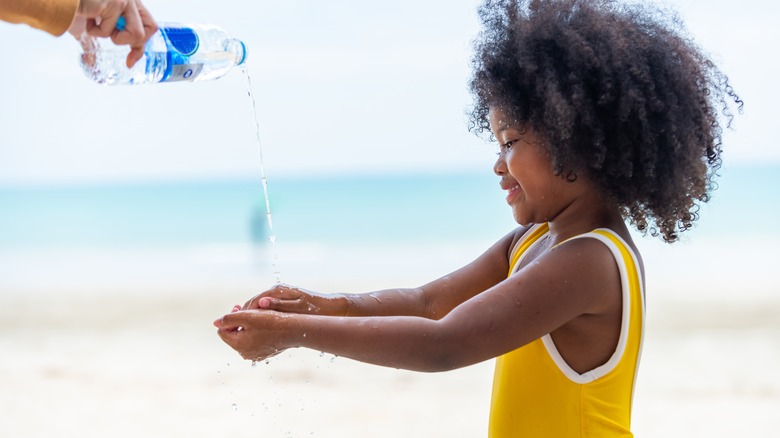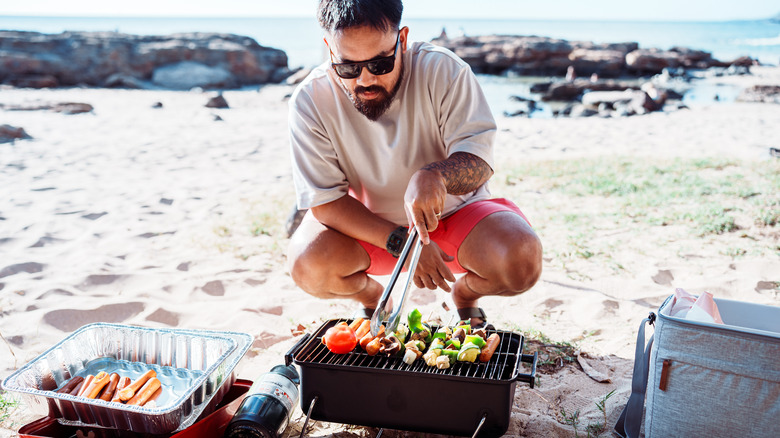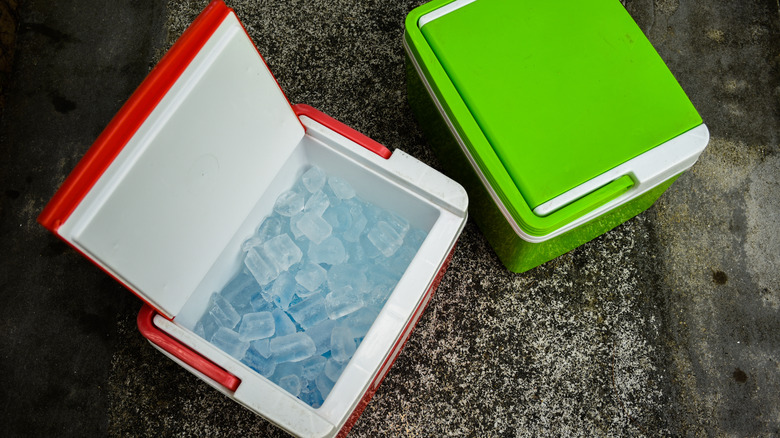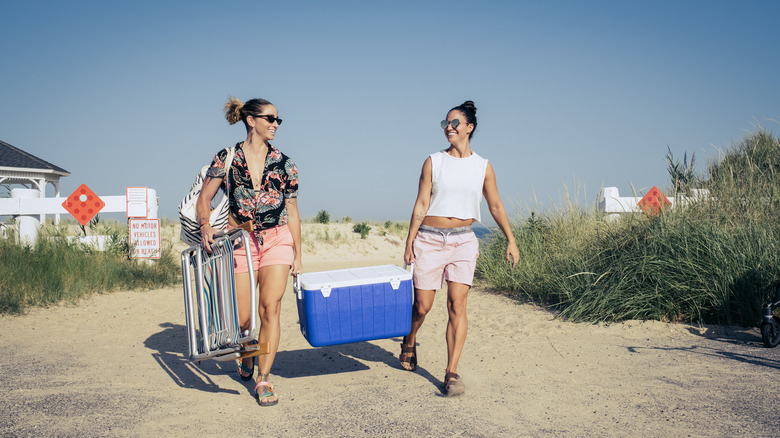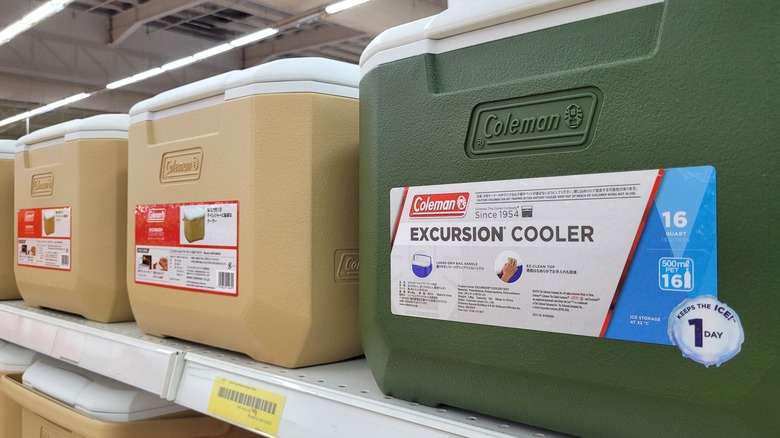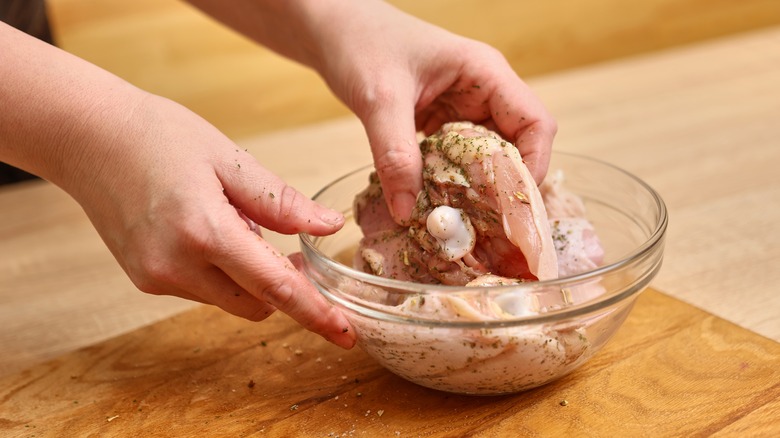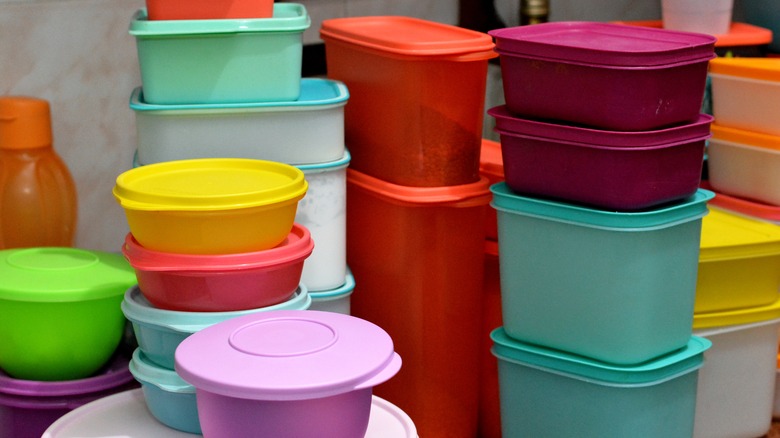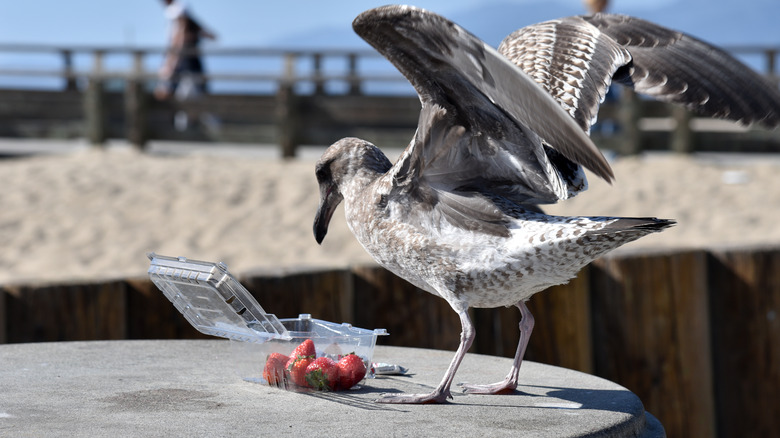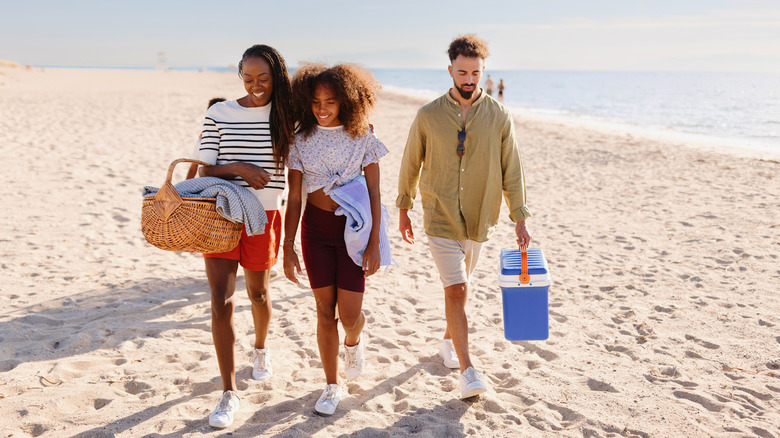12 Expert Tips For Safely Storing And Handling Food At The Beach
If there's a beach to be found anywhere near where you live, you probably look forward to spending time there during the summer's heat. It's a chance to cool off in the water, enjoy boating or water skiing, make memories and — of course — enjoy some outdoor dining.
Whether you pack a cold meal or bring your grill to the beach, waterside eating poses a few specific challenges on the food safety front. The basics of food safety remain the same: Keeping hot foods hot and cold foods cold, using clean hands and utensils, and avoiding cross-contamination. Those things are all possible at the beach, they're just harder and take a little more planning.
That's a topic I can speak to from personal and professional experience. I'm a trained chef, and a former restaurateur and food safety trainer. And having grown up on the East Coast, I've enjoyed my share of waterfront cookouts. With that background to draw on, I have several important tips to help ensure that your fun day out won't result in anyone getting sick.
1. Allow enough cooler space for both food and ice
A day out at the beach means hauling everything you need from your vehicle to your chosen spot. Ideally, that would mean just a single trip, but in practice (especially if you have kids) it often turns into several round trips.
That's a lot of time to spend trudging across the hot sand, so there's real motivation to pare back on what you bring. Minimizing the number of coolers you use is an obvious temptation here, but it's one you should avoid. A good rule of thumb with picnic coolers is to use just ⅓ of the space for your actual food, and ⅔ for ice or gel packs. To put that another way, you need two parts ice to one part food to keep food fresh all day. So loading up your cooler first with food and drinks — and then trying to shoehorn your ice packs into it — is a really bad idea.
It's much smarter to eyeball the volume of food you plan to bring along, and then mentally double that to account for the ice or gel packs you'll need. Having enough chilling capacity is one of the most fundamental ways to maintain food safety during your day at the beach. Don't skimp; you're better off borrowing or buying additional coolers instead.
2. Monitor your cooler's temperature with a thermometer
During an extended visit to the beach, you'll need food to keep you energized and beverages to keep you hydrated. Your drinks don't need a whole lot of attention. Aside from milk, it's perfectly fine for most beverages to get warm. You can just add ice later to chill them again.
That's very much not the case with most foods. Perishable foods like meats, poultry, eggs, dairy products, and especially seafood can quickly become dangerous if they're allowed to creep into the food safety "danger zone," which is temperatures between 40 degrees and 140 degrees Fahrenheit. The only way to know for sure that your cooler is keeping your food safe is to monitor it with a thermometer.
Ordinary fridge thermometers are adequate, but you can't check the temperature on one without opening the cooler's lid. That means you're letting cold out and heat in every time. It's better to use the kind of probe thermometer you see people use for grilling. Slide the probe between (or into) your most perishable foods, pack the rest of the cooler, and tape the thermometer's display to the cooler. You can monitor the temperature on the display, and higher-end models can even transmit temperatures or alerts to your phone.
3. Keep your cooler cool on the outside
Coolers have well-insulated walls and they're typically designed so that their lid is reasonably airtight when closed. Even when it's sitting in direct sunlight, a well-made cooler will still keep your food cold — but that's a worst-case scenario that makes the cooler less effective.
Shade is usually at a premium when you're at the beach, so parking your coolers in a shady spot is seldom an option. There are a couple of ways to work around this. One is designating an extra beach umbrella just for the coolers or putting up some kind of sunshade or other shelter.
You can also give the coolers a lower-temperature environment by digging down past the surface layer of hot sand and nestling your coolers into the cooler sand underneath. An alternative (or complementary) option is using a spare blanket to insulate your cooler(s) from the outside. It's possible to store hot food this way (like that pork butt you've just taken from the smoker), but it works for cold food as well.
4. Bring hand washing or hand sanitizing options
One of the things that makes food prep at the beach a little more challenging is the lack of hand-washing options. Some beaches may have washroom facilities with running water, where hands can be washed, but that's the exception rather than the rule.
The lack of hand-washing facilities is a problem. Frequent hand-washing is a must any time you're handling food, especially if you're handling raw food. This is very often how foodborne illness spreads, as unwashed hands go from raw food to cooked food or from raw food to utensils.
Unless you know for certain that you'll have access to formal handwashing facilities, you'll need to provide them yourself. Plan around a hand-washing station, with a bowl, extra water and soap, and some paper towels for drying. Aside from its food safety benefits, it means you're a lot less likely to get sand in your food! As a backup, bring along hand sanitizer as well. It's not as good as washing, but it's a very useful second option and it can help conserve the water you've brought along.
5. Pack raw foods separately
If you plan to grill while you're at the beach, you'll need to pay even more attention to food safety. Packing and handling raw ingredients safely, especially meats and seafood, requires some very specific measures.
First and foremost, you need to keep raw meats and fish separate from anything that's already cooked or that will be served raw. Juices migrating from raw foods to ready-to-eat can contaminate everything and sharply increase the risk of making someone ill. Ideally, you'd pack two coolers: One you'll open regularly for drinks and snacks, and another that stays closed, protecting your raw ingredients until it's time to cook.
If that's not possible, there are a few workarounds to keep things safe in just one cooler. This includes keeping raw ingredients in containers with tight-fitting lids (rather than their original packaging) to prevent leaks. Pack anything raw at the bottom of the cooler, so that if any leaks escape, they can't trickle down and contaminate other foods. Keep a layer of ice or gel packs between the perishable raw foods below, and anything above. A sheet pan filled with ice and frozen can provide that barrier, as well as a convenient way to organize your cooler. Beverages and snacks should be above the frozen divider, and your raw foods should stay below it.
6. Don't leave empty space in your cooler
Dividing high-risk foods into one cooler and low-risk foods into another is a good organizing principle when you're packing for the beach. One unfortunate downside to what's otherwise a "best practice" is that you may have some extra space in your cooler.
That airspace isn't filled with anything cold. Simple physics (the second law of thermodynamics, to be precise) tells us that warmth from the air will be drawn into your ice or gel packs, helping melt or thaw them. That's not at all what you want during a long day at the beach.
There are a couple of ways you can constructively fill up that space. One is with an extra blanket or a few towels, or anything else that has some insulating value. Your other option is to fill up that space with more cooling capacity. Frozen water bottles are ideal: They take up the space and keep things cold, and as they thaw you can take them out and drink them. Additional ice and gel packs fit the bill as well, though you don't get the benefit of extra hydration.
7. Pack a separate cooler just for ice
No matter how good your cooler is, or how well you shade it, the ice inside will eventually melt or the gel packs will thaw. The various tips and hacks we've discussed here can help, but eventually, your cooling will fail and the temperature of your foods will start to rise.
If there's an ice concession at the beach, buying more ice (often at an inflated price) is one way to resolve the problem. A better option is simply to pack along extra cooling capacity from home, bringing a spare cooler packed to the brim with ice or gel packs. For really hot or long days, you may even want to bring two of them.
This simple step gives you plenty of options to help you keep your food safe and your beverages perfectly chilled, even on the longest beach days. You'll be able to top up your snacks-and-beverages cooler frequently and lower the temperature of your most perishable foods anytime your thermometer says they're starting to warm up. It'll even give you enough extra capacity to keep your leftover food safe until you get home.
8. Choose coolers that fit your use-case
There are a lot of different kinds of picnic coolers. Like, really a lot. Some of them are big, metal-clad beasts meant for weekend camping, while others can be as simple and appealing as an old-fashioned picnic basket with an insulated shell.
The trick is to find one that does what you need it to do, in a size you can manage. Lightweight, soft-sided coolers are easy to sling over your shoulder, but their carrying capacity is usually pretty limited. Big, heavy coolers have lots of capacity, but you'll work up a sweat dragging one across the hot sand. Many of them have wheels and a handle for pulling, but wheels won't help much once you leave the parking area or sidewalk and hit the actual beach.
So give some thought to your usage before you buy your next cooler. Think about how much food and drink you typically take along, and how much cooler capacity you'll need to fit both the food and the ice to keep it cold. Give some thought, too, to whether one or two big coolers fit your needs better than a handful of smaller ones (and how much other "beach stuff" you'll be carrying back and forth). There are no hard-and-fast answers here — it'll largely come down to your personal preferences.
9. Prep and season your foods before leaving home
This is a big one. I've talked about the ways you can handle food safely while you're at the beach, and how to manage washing and sanitizing. But realistically, it's a lot easier and safer to do as much of your prep as possible at home.
In your home kitchen, you have everything you need to do food prep safely and conveniently, so lean into that: Peel and cut those fruits and veggies ahead of time. Season the raw meats, and pack them in their marinades so they can go straight onto the grill or campfire. Also, any foods that are going with you in the cooler tomorrow should go into the refrigerator tonight — even things like pickles that only need refrigeration after they're opened. Everything that goes into the cooler should be cold beforehand, so your ice and gel packs will last as long as possible.
Doing all of this prep at home sharply reduces the risks of cross-contamination because you have running water at hand for washing your hands and utensils. You should still have hand-washing options at the beach, but minimizing your need for it in the first place is better. Also, when you prep food at the beach, sand somehow always seems to find a way in. I've crunched on enough sandy food (ugh) for one lifetime, and anything I can do to avoid it is welcome.
10. Pack your foods in containers rather than bags
When packing your cooler for the beach you should think in terms of food storage containers, rather than bags. Bags are unquestionably convenient, but containers have a lot of crucial advantages when you're packing food to go.
First, they're physically neater and easier to stack. Containers with suitably sturdy, airtight lids do a much better job of keeping sand out, and juices (which is to say, potential contamination). They're also an organizational tool, which is worth considering. Inside or outside of your cooler, they provide a way to sort your snacks and keep them closed up, where insects can't get in and passing birds can't help themselves. A handful of clear pantry containers, for example, can be a great way to store your crunchy snacks so they don't get crushed along the way.
See-through containers, clearly labeled on the top, make it quick and easy to find what you're looking for in the cooler, so the lid spends more time closed and the cold says inside. Finally, most food storage containers are reusable indefinitely (and recyclable when they wear out or break), which makes them a better choice for environmental reasons as well.
11. Keep foods packed away when you're not eating
There are two pressing reasons to keep your food packaged up when you're not actually eating it. One is that almost everything you bring along will keep better if it stays cold for as long as possible. The other reason is that keeping your food packed up prevents unwanted things from getting into your food, from sand to, uh ... seagulls.
Okay, seagulls are definitely not as intimidating a threat as, say, grizzlies at a mountain campsite. But they are decidedly more irritating than ants at a picnic, and not something to take lightly. The feathered nuisances are often unafraid of humans, and will happily watch and wait for an opportunity to swoop in and help themselves to any food you've left unsecured.
The last thing you want is for seagulls to develop a sense of entitlement about the food you've brought along with you (trust me on this one). You definitely don't need to bear-proof your food for a day at the beach, but following the same rules campers use to deter raccoons and other critters will help keep the gulls at bay.
12. Plan for getting your food home again
Hikers in national parks and ecologically sensitive areas are frequently reminded to take nothing but photos and leave nothing but footprints. That's a good rule to follow at the beach as well: Like any stretch of coastline, beaches are ecologically sensitive areas themselves, and studies carried out during the COVID-19 lockdown showed that beach ecosystems bounced back strongly when humans were absent.
In practical terms, leaving "nothing but footprints" after a day at the beach involves a few obvious things like bagging your trash and putting it in bins, or packing it away with you. Dealing with your leftover food is a less obvious issue. If you've planned ahead and have extra cooling capacity, you can keep any uneaten food or leftovers safe until you get home.
If you've brought multiple coolers, refresh the ice or gel packs in one of them. Pack any remaining raw or perishable foods into the bottom, where they'll be colder and can't leak on the foods above. If you have a probe thermometer, position it at this level for monitoring purposes. Pack leftovers and uneaten food back into the cooler as soon as possible, ideally while they're still cold. Any perishable foods that have been sitting out for two hours or longer (or just one hour at 90 degrees Fahrenheit or higher) should be bagged and discarded with the trash because they're no longer food-safe.
